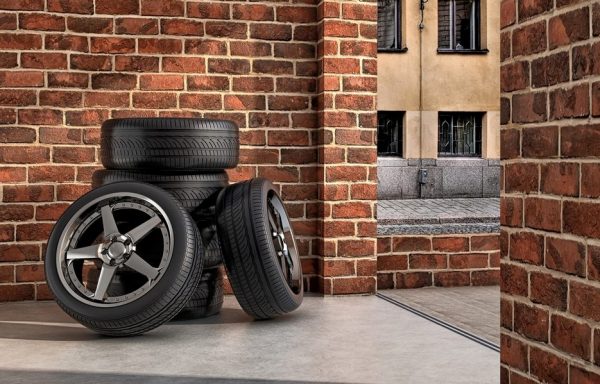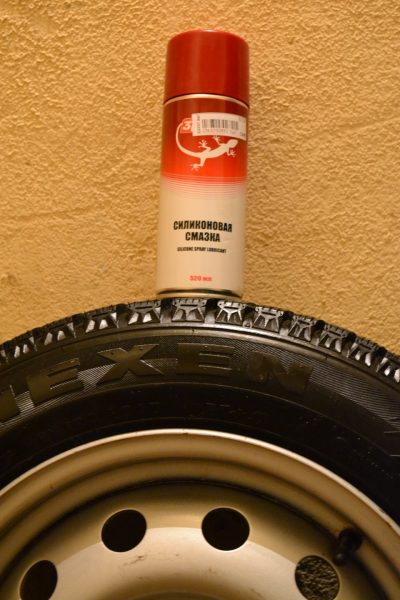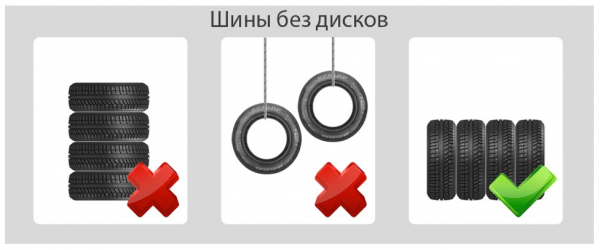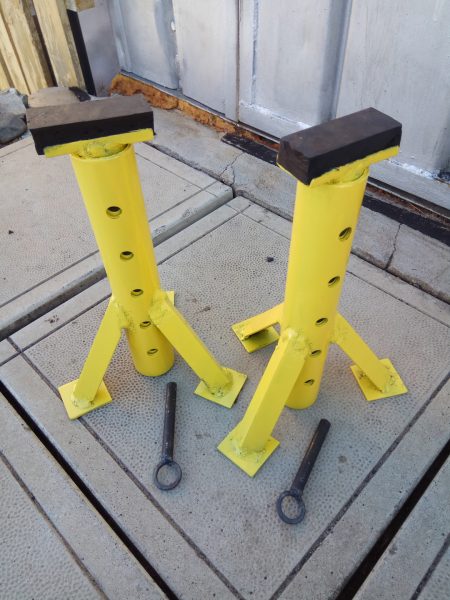
How to properly store rubber on disks and without: we consider all the nuances
Content
The tires on the car must be changed twice a year: summer to winter and vice versa. To prevent unused rubber from losing its characteristics, it must be properly stored. Consider the rules that must be followed when storing rubber on disks and without them.
What is the risk of improper tire storage?
To ensure a high-quality and safe ride, the car must be equipped with good tires that match the season. When storing unused rubber, you need to know how to do it correctly. It is not only the room in which it is stored that matters, but also the method of location. Tires on disks and without them must be stored in different ways.
Drivers often make the following mistakes when storing tires:
- storage of rubber without discs in a lying position, laying one tire on top of another;
- laying rubber in a narrow place where it is difficult to enter;
- installation of heavy objects on top of tires;
- direct sunlight on the rubber or near a heat source. This leads to drying out of the tires, the appearance of microcracks, cord delamination;
- storing in a high humidity room will cause the discs to rust and the rubber will become brittle.

Improper storage of rubber leads to its deformation, as a result of which the following problems arise:
- the tire is difficult to put on the disk;
- it is impossible to inflate the wheel, as the tightness of the fit of the tire on the disk is disturbed;
- cannot be balanced;
- microcracks appear, reducing strength.
Features of storing rubber on disks and without them
Is there a difference in storage of winter and summer tires? There are no particular differences, but still there are certain nuances:
- since winter tires are soft, it is recommended to store them only on disks;
- winter tires have a deeper tread, so it must be thoroughly cleaned of dirt and stuck objects;
- winter wheels are more afraid of high temperatures and sun rays;
- so that summer rubber does not crack, it should be stored only in a warm room.
There are also differences in storing tires on disks and without them. They consist in the correct location of each ring.
Which storage location to choose and how to prepare the rubber
Before placing the rubber for storage, it must be cleaned of dirt, removed from the tread stones, leaves, etc. that have got there, washed and dried well. You can only pack tires in special covers or bags made of natural materials.
Where tires cannot be stored:
- Staircase, common vestibule near the apartment. There are no necessary conditions here, and the tires will interfere with other residents.
- Unheated garage.
- Near heat sources.
- Uneven surfaces or shelves with sharp edges.
- Unglazed balcony.
Where is it recommended to store tires:
- Apartment or dry storage room.
- Heated glazed balcony.
 You can store tires on a glazed heated balcony
You can store tires on a glazed heated balcony - Heated garage.
- Dried cellar.
- Tire center.
 Tire center - a place designed to store tires
Tire center - a place designed to store tires
The advantages of storing in an apartment or garage is that this option does not require money. The main disadvantage of this option is that it will be difficult to maintain the conditions necessary for the proper storage of rubber. In addition, the wheels take up a lot of space, and there is always not enough space.
Tire centers ("tire hotels") create the necessary conditions for storing wheels, but the cost of such a service will depend on the size of the tires. Do not think that dust particles will be blown off your wheels here, they are just in a safe place and do not interfere with your home or garage. Storage of one set will cost from 2000 to 4000 rubles per season. Usually, there is a tire service near such storage facilities, where discounts are made to their customers when replacing tires.
How to process tires
After the tires have been cleaned of dirt, washed and dried well, they can be treated with a special agent. For this, a silicone grease is used. Do not confuse it with products used to restore the color of rubber, as they contain a solvent. Silicone grease, after being applied to the tire, is absorbed into the existing micropores and displaces all moisture from them.

How to properly stack tires without and with discs
Tires on disks are laid as follows:
- rubber should not be placed while standing;
- You can store lying down, placing one wheel on top of the other, but no more than 4 pieces;
- the best option is a suspended state;
- a pressure of about 1-1,5 atm is set in the tire so that the rubber does not inflate.

Storing tires without disks has its own characteristics:
- cannot be stored suspended;
- it is forbidden to store the rubber lying down, stacking one on top of the other;
- the rubber is installed standing up and during storage every 3-4 weeks it rotates by 30о.

In both cases, it is better to place the wheels in special covers, and if they are not there, then in bags made of natural materials.
Storing tires on a car
If you do not plan to operate the car for some time, then the tires can be stored directly on it:
- if possible, the machine is installed on special stands;
 Putting the car on stands allows you to unload the tires
Putting the car on stands allows you to unload the tires - tires are covered with dense material to protect against external negative factors;
- if there are no supports, then it is necessary to reduce the weight of the car as much as possible and inflate the tires to the maximum permissible indicator;
- once a month it is necessary to change the position of the wheels (spin them or move the car).
Storage conditions
So, let's outline the main nuances of storing tires with and without disks:
- the rubber on the disks can be stored horizontally or in a hanging position;
- tires without a disk are stored only while standing;
- once every 3-4 weeks, the wheels in the stack must be swapped or turned;
- you cannot store rubber in plastic bags;
- the temperature should be within + 10–25оWITH;
- direct sunlight is excluded;
- the humidity in the room should be about 50–70%.
Compliance with simple rules will allow you to keep the rubber in good condition and during storage it will not lose its original characteristics.
Video: how to store tires
The experience of car enthusiasts
It is best to store tires on rims, half-flat. Then you can hang it (by the disk, of course) or store it horizontally. If without discs - only in a vertical position. I haven't heard of spacers, I think that without them it will be OK. It is not necessary to hang the tire - it will deform at the attachment point under its own weight.
You can store it anywhere, just not on the stove. I store it in an unheated garage, I don’t care about frost during storage. rubber does not like high heat - it dries, it may crack slightly.
It is recommended to stack. If stored vertically, turn occasionally. He kept it in every way, incl. and vertically without turning. I didn't see anything bad.
To store wheels and other useful goodies for our fleet, we rented a cell in a warehouse for storing all sorts of things. I don’t spray anything, I just stuff it into special plastic bags with strings (like garbage ones, but stronger) so that the dust does not set. The male Jumper has special cases for storing rubber (such as raincoat fabric stitched with oilcloth from the inside). They were included with the car. In the old days, rubber was generally on the balcony all year round. Nothing was done to her. It wears out faster than its chemical-physical properties change under the influence of external forces.
In a good way, they need to be stored in a vertical position (on the tread) in a deflated state, mounted on a disk. A place is suitable in a stationary heated garage or in utility boxes, mezzanines, in an apartment, if any. My summer tires are stored in the Volga salon on the floor and on the back seat in a high-rise building, where it hibernates, while in winter I cut through the all-wheel drive Niva.
I keep Toyota in a tire hotel, in a salon in Lyubertsy. In my opinion, the most reasonable thing is inexpensive, without the risk that they will deteriorate, and there is not much free space.
It must be understood that tires are not such a product as milk or meat, for the storage of which ideal conditions are created. It is enough to follow simple rules in order to preserve its characteristics during storage. Remember that the durability of the tires depends on the condition of the tires, and most importantly, the safety of traffic.




